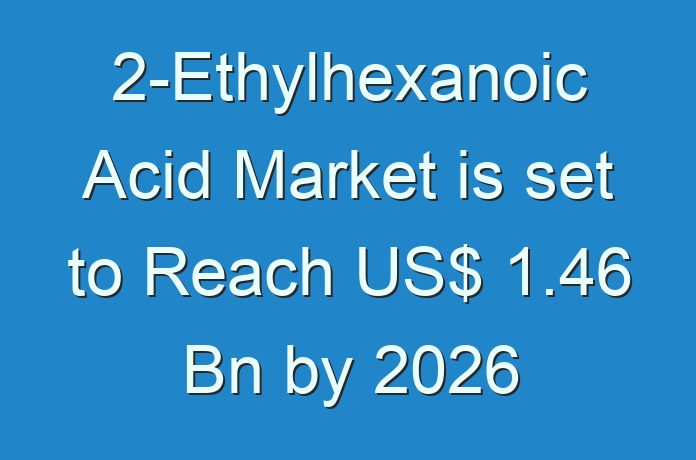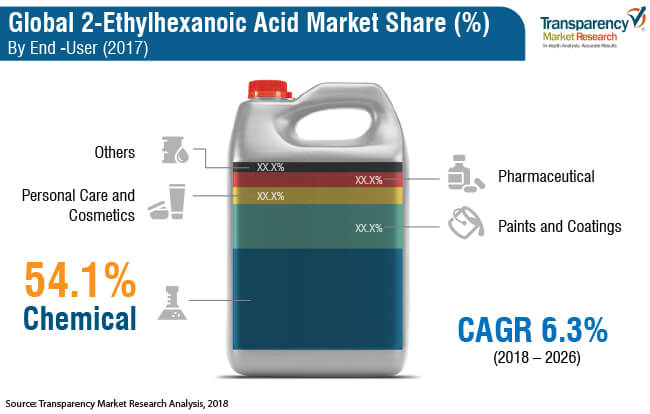
2-Ethylhexanoic Acid Market – Snapshot
2-Ethylhexanoic acid, a member of the medium-chain fatty acids family, occurs as a light-yellow-colored liquid with mild odor. It is commonly used in the preparation of metal derivatives that are soluble in non-polar organic solvents. Metal derivatives thus produced are used as catalysts in polymerization reactions. 2-Ethylhexanoic acid is generally used in esters for polyvinylbutyral film plasticizers and synthetic lubricants, in metal salts for paint dryers, in automotive coolants, PVC stabilizers, and cosmetics. The butyraldehyde method and the octanol method are two common processes by which 2-ethylhexanoic acid is produced. 2-ethylhexanoic acid is a carboxylic acid and it reacts with almost all bases with the release of a substantial amount of heat. 2-Ethylhexanoic acid can be oxidized by strong oxidizing agents and reduced by strong reducing agents. It initiates polymerization reactions and catalyzes chemical reactions.

Based on method of production, the global 2-ethylhexanoic acid can be categorized into butyraldehyde and octanol. Butyraldehyde is a highly preferred and the most common method of production, wherein propylene is the major raw material used. 2-Ethylhexanoic acid is produced industrially from propylene, which then undergoes hydroformulation to obtain butyraldehyde.
Request Brochure @
https://www.transparencymarketresearch.com/sample/sample.php?flag=B&rep_id=37172
In terms of application, the global 2-ethylhexanoic acid market can be divided into PVB plasticizers, synthetic lubricants, paint dryers, PVC stabilizers, drugs, emollients, and others. 2-Ethylhexanoic acid is compatible with polyvinylbutyral and it exhibits good chemical resistance. Metallic salts of 2-ethylhexanoic acid are used as dryers in the production of odorless paints, inks, varnishes, and enamels. Metallic salts of 2-ethylhexanoic acid based on cobalt and manganese are commonly used as paint dryers. Based on end-user, the global 2-ethylhexanoic acid market has been classified into chemical, paints & coatings, personal care & cosmetics, pharmaceutical, and others.
REQUEST FOR COVID19 IMPACT ANALYSIS –
https://www.transparencymarketresearch.com/sample/sample.php?flag=covid19&rep_id=37172
Increased demand for use of 2-ethylhexanoic acid as PVB plasticizers is likely to boost the demand for 2-ethylhexanoic acid in the near future. 2-Ethylhexanoic acid is primarily used as a PVB plasticizer, which, in turn, is used in the manufacture of glass. Use of 2-ethylhexanoic acid as a PVB plasticizer explores its property of enhancing the solubility. When used as a PVB plasticizer, 2-ethylhexanoic acid provides high transparency, impact resistance, high tensile strength, and elasticity. Rising usage of PVB films and sheets in building & construction and infrastructure sectors is expected to increase the demand for 2-ethylhexanoic acid in the near future. Increase in the demand for 2-ethylhexanoic acid for use as a PVC stabilizer is another major factor driving the global 2-ethylhexanoic acid market. At high temperatures, chlorine and hydrogen from PVC start getting eliminated and the release of hydrogen chloride becomes evident. 2-Ethylhexanoic acid prevents emission of chlorine and hydrogen from PVC. Demand for PVC for use in applications such as pipes and fittings, window profiles, wires and cables, coatings, and flooring is on the rise.
2-Ethylhexanoic acid is likely to witness increase in the demand from corrosion inhibition and cosmetics & personal care applications. Due to presence of various ions as well as high temperatures and pressures, automotive engine components are exposed to corrosion. 2-Ethylhexanoic acid acts as a corrosion inhibitor and prevents failure of engine components. 2-Ethylhexanoic acid is used as emollient in personal care products and cosmetics. It functions as a skin- and hair-conditioning agent in personal care products. 2-Ethylhexanoic acid is used as a lubricant on the skin’s surface in order to obtain soft and smooth appearance and gloss. Increase in population and rise in awareness about personal hygiene are likely to act as growth opportunities for the 2-ethylhexanoic acid market in the next few years. Advancements in the industrial sector are likely to boost the demand for 2-ethylhexanoic acid across the world in the near future. Asia Pacific is a major region of the global 2-ethylhexanoic acid market, owing to presence of key manufacturers in countries such as Japan and China. Production of 2-ethylhexanoic acid is highly concentrated in countries such as Japan, Germany, and Sweden.
Stringent regulations on the emission of volatile organic compounds have enhanced the consumption of water-based coatings. Water-based coatings do not require dryers, which eliminates the need for dryers such as 2-ethylhexanoic acid. Thus, emergence of water-based coatings is likely to restrain the 2-ethylhexanoic acid market from 2018 to 2026.
The 2-ethylhexanoic acid market is dominated by a few multinational players. This leads to intense competition in the market. Manufacturers such as The Perstorp Group, BASF SE, The Eastman Chemical Company, Elekeiroz, OXEA Chemicals, and KH Neochem Co., Ltd are some of the leading players operating in the market. Capacity expansion and acquisitions are a few strategies adopted by these companies to retain their market position. Large players are highly integrated, which helps them decrease production costs and gain a competitive edge in the market. Key players are focused on the innovation of new technologies in order to gain market share and serve a diverse range of end-user industries.





